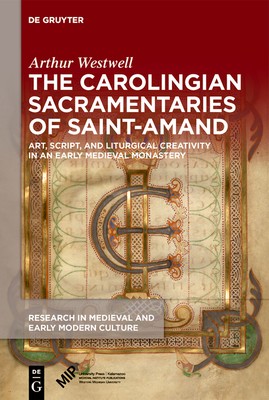
- We will send in 10–14 business days.
- Author: Arthur Westwell
- Publisher: Medieval Institute Publications
- ISBN-10: 1501521209
- ISBN-13: 9781501521201
- Format: 15.6 x 23.4 x 2.9 cm, kieti viršeliai
- Language: English
- SAVE -10% with code: EXTRA
Reviews
Description
The series of sacramentaries made at Saint-Amand in the later ninth century are a neglected testament to the creativity of the early medieval monastic scriptorium. These books contain prayers for celebration of the Mass, and display the creative and active engagement of medieval compilers with this especially adaptable genre. Uniquely for such an early period, ten manuscripts from the monastery survive in whole or in part, which were produced rapidly in a period of just over two decades. The Saint-Amand manuscripts are also especially creative examples of this genre, and they had demonstrable and lasting influence in centers across Europe.
Liturgical books have rarely been employed to demonstrate medieval creativity, and the Sacramentary is an especially complex tradition. Yet such books display, to a unique extent, how scribes processed and adapted a hugely diverse and varied tradition, going far beyond modern categories and assumptions about how such books were used and how they changed. This book makes these sources accessible and bridges disciplinary barriers, in order to make new contributions to how we understand and can employ these testimonies to medieval intellectual and religious culture.
In-depth study of script, decoration, and content enables a new appreciation of the context in which the Saint-Amand manuscripts were produced. It foregrounds ecclesiastical patronage, political and intellectual dynamics at the waning of Carolingian power, and the intensive collaboration of scribes, artists, and liturgical composers. This books offers a unique view into an early medieval monastic scriptorium at work.
EXTRA 10 % discount with code: EXTRA
The promotion ends in 21d.18:34:20
The discount code is valid when purchasing from 10 €. Discounts do not stack.
- Author: Arthur Westwell
- Publisher: Medieval Institute Publications
- ISBN-10: 1501521209
- ISBN-13: 9781501521201
- Format: 15.6 x 23.4 x 2.9 cm, kieti viršeliai
- Language: English English
The series of sacramentaries made at Saint-Amand in the later ninth century are a neglected testament to the creativity of the early medieval monastic scriptorium. These books contain prayers for celebration of the Mass, and display the creative and active engagement of medieval compilers with this especially adaptable genre. Uniquely for such an early period, ten manuscripts from the monastery survive in whole or in part, which were produced rapidly in a period of just over two decades. The Saint-Amand manuscripts are also especially creative examples of this genre, and they had demonstrable and lasting influence in centers across Europe.
Liturgical books have rarely been employed to demonstrate medieval creativity, and the Sacramentary is an especially complex tradition. Yet such books display, to a unique extent, how scribes processed and adapted a hugely diverse and varied tradition, going far beyond modern categories and assumptions about how such books were used and how they changed. This book makes these sources accessible and bridges disciplinary barriers, in order to make new contributions to how we understand and can employ these testimonies to medieval intellectual and religious culture.
In-depth study of script, decoration, and content enables a new appreciation of the context in which the Saint-Amand manuscripts were produced. It foregrounds ecclesiastical patronage, political and intellectual dynamics at the waning of Carolingian power, and the intensive collaboration of scribes, artists, and liturgical composers. This books offers a unique view into an early medieval monastic scriptorium at work.


Reviews